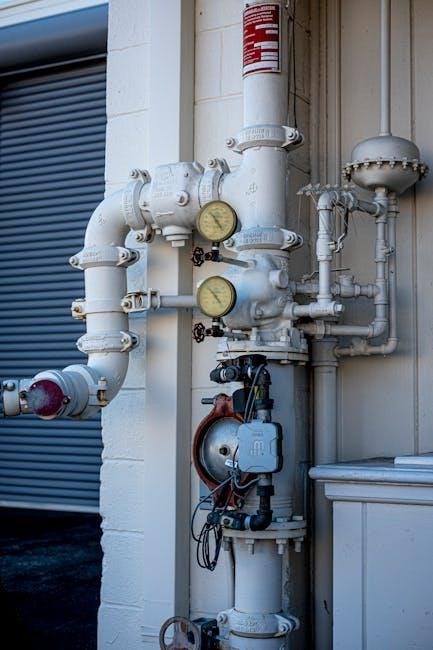The equivalent length of pipe fittings is a method used to calculate pressure loss in piping systems, utilizing tables and equations to determine overall system efficiency and performance accurately always online.
Definition and Purpose
The equivalent length of pipe fittings is defined as the length of straight pipe that would produce the same pressure drop as the fitting, allowing for accurate calculation of pressure loss in piping systems.
The purpose of equivalent length is to provide a simple and effective method for calculating pressure drop in complex piping systems, taking into account the effects of various fittings and valves on flow rate and pressure.
This method is widely used in the design and operation of piping systems, including water, gas, and oil pipelines, as well as in the chemical and power industries.
The equivalent length method is based on the principle that the pressure drop across a fitting or valve is equivalent to the pressure drop across a certain length of straight pipe, making it a useful tool for engineers and designers.
The equivalent length of pipe fittings table pdf provides a comprehensive list of equivalent lengths for various fittings and valves, making it easier to calculate pressure drop and design efficient piping systems.
The use of equivalent length tables and equations enables engineers to optimize piping system design, reduce energy losses, and improve overall system performance.
The equivalent length method is a valuable tool for anyone involved in the design, operation, and maintenance of piping systems.
The equivalent length of pipe fittings is an important concept in fluid mechanics and piping engineering, and its application is essential for ensuring the safe and efficient operation of piping systems.
The equivalent length method is a widely accepted and widely used technique in the industry, and its application is essential for ensuring the safe and efficient operation of piping systems, and for optimizing system design and performance.

Calculating Equivalent Length
Equivalent length is calculated using equations and tables to determine pressure loss in piping systems accurately online always.
Methodology
The methodology for calculating equivalent length involves using tables and equations to determine the pressure loss in piping systems. This approach takes into account the type of fitting, pipe diameter, and flow rate to calculate the equivalent length. The equivalent length is then added to the total pipe length to determine the overall pressure loss. The methodology is based on the principle that the pressure loss in a piping system is proportional to the length of the pipe and the type of fittings used. By using the equivalent length methodology, engineers can accurately calculate the pressure loss in a piping system and design the system to meet the required specifications. The equivalent length methodology is widely used in the industry and is considered a reliable and accurate method for calculating pressure loss in piping systems. The methodology is also used to calculate the equivalent length of valves and other fittings.

Equivalent Length Tables
Equivalent length tables provide values for various pipe fittings and valves, helping engineers calculate pressure loss accurately using online resources always available for download instantly.
Table A: Equivalent Length Values
Table A provides a comprehensive list of equivalent length values for various pipe fittings and valves, including globe valves, butterfly valves, and plug type seats. The table lists the equivalent length values as (L/D)EQ, which represents the length of straight pipe that would produce the same pressure drop as the fitting. The values are organized by item name and type, with conditions such as fully open or partially closed. For example, a globe valve has an equivalent length value of 6, while a butterfly valve has a value of 40. The table also includes values for other fittings, such as reducers, elbows, and tees. By using these equivalent length values, engineers can accurately calculate the pressure loss in a piping system and design more efficient systems. The table is an essential resource for anyone working with pipe fittings and valves, and is available for download in PDF format online.
Components Included in Equivalent Length Tables
Valves and fittings are included in equivalent length tables for accurate pressure loss calculations always using online resources and documents.
Valves and Fittings
Valves and fittings are crucial components in piping systems, and their equivalent lengths are essential for accurate pressure loss calculations. The equivalent length of a valve or fitting is the length of straight pipe that would produce the same pressure drop as the valve or fitting. This value is used to calculate the total equivalent length of a piping system, which is then used to determine the overall pressure loss. Tables and charts are available online to provide the equivalent lengths of various valves and fittings, including globe valves, butterfly valves, and check valves. These tables typically list the equivalent length as a function of the valve or fitting type, size, and configuration. By using these tables, engineers and designers can easily determine the equivalent length of valves and fittings in their piping systems, ensuring accurate pressure loss calculations and efficient system design. The equivalent length values are usually provided in units of length, such as inches or feet.

Pressure Drop Calculation
Pressure drop calculation involves using equivalent length values to determine overall system efficiency and performance accurately online always using tables and equations provided in the document for reference.
Sheet and Components
The document contains a sheet that lists piping system components, their quantities, and properties to calculate pressure drop through a gas piping system, including equivalent length values for various fittings.
The sheet provides a comprehensive overview of the components used in the piping system, allowing engineers to accurately calculate pressure drop and determine the overall efficiency of the system.
The components listed include valves, fittings, and accessories, each with its corresponding equivalent length value, which is used to approximate the impact of the fittings on pressure loss across the piping length.
By using the sheet and equivalent length values, engineers can ensure accurate pressure loss calculations and optimal system design.
The sheet is a valuable tool for engineers and designers, providing a straightforward and efficient method for calculating pressure drop and determining the equivalent length of pipe fittings.
The components and sheet are essential for accurate pressure drop calculations, and the equivalent length values are used to determine the overall efficiency of the piping system.

Importance of Equivalent Length in Pipe Fittings
Equivalent length is crucial for accurate pressure loss calculations and optimal pipe fitting system design always considering online resources and tables for efficiency and performance metrics available.
Accurate Pressure Loss Calculation
To achieve accurate pressure loss calculations, engineers rely on equivalent length tables and equations, such as the Hazen-Williams or Darcy-Weisbach equations, to determine the overall pressure loss in a piping system.
The equivalent length method is a widely accepted approach, which involves calculating the equivalent length of each pipe fitting and adding it to the total pipe length.
This approach allows for a more accurate calculation of pressure loss, taking into account the specific characteristics of each pipe fitting, such as valves, elbows, and tees.
By using equivalent length tables, engineers can quickly and easily determine the equivalent length of each fitting, and then use this information to calculate the total pressure loss in the system.
The use of equivalent length tables and equations enables engineers to design and optimize piping systems with greater accuracy and efficiency, which is essential for a wide range of industries, including oil and gas, water treatment, and power generation.
The equivalent length method is a valuable tool for engineers, allowing them to calculate pressure loss with greater precision and confidence, and to design systems that meet specific performance and safety requirements.
Overall, the equivalent length method is a crucial component of piping system design, and its use is essential for ensuring the safe and efficient operation of piping systems.
The equivalent length tables provide a comprehensive list of equivalent lengths for various pipe fittings, making it easier for engineers to calculate pressure loss and design optimal piping systems.
The use of equivalent length tables and equations has become a standard practice in the industry, and its importance cannot be overstated.
The equivalent length method has been widely adopted, and its use continues to grow as engineers seek to design and optimize piping systems with greater accuracy and efficiency.
The equivalent length tables are widely available, and can be easily accessed online, making it easier for engineers to calculate pressure loss and design optimal piping systems.
The equivalent length method is a valuable resource for engineers, and its use is essential for ensuring the safe and efficient operation of piping systems.
The equivalent length tables provide a valuable resource for engineers, allowing them to calculate pressure loss with greater precision and confidence.
The equivalent length method is a crucial component of piping system design, and its use is essential for ensuring the safe and efficient operation of piping systems, and the equivalent length tables are an essential tool for engineers.
Equivalent length of pipe fittings table pdf provides valuable information for engineers to design and optimize piping systems efficiently and effectively always using online resources available today.
The equivalent length of pipe fittings table pdf is a comprehensive resource that provides equivalent length values for various pipe fittings and valves. This table is essential for engineers and designers to calculate pressure loss in piping systems accurately. The table includes equivalent length values for different types of fittings, such as elbows, tees, and valves, and is organized by pipe diameter and fitting type. By using this table, engineers can easily determine the equivalent length of pipe fittings and calculate the overall pressure loss in a piping system. The equivalent length of pipe fittings table pdf is a valuable tool for anyone involved in the design and operation of piping systems, and is widely available online for easy reference and download. The table is regularly updated to reflect new research and industry standards, ensuring that users have access to the most accurate and reliable information.
